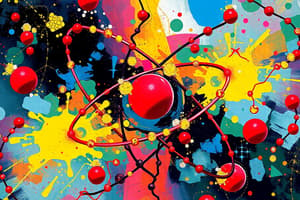Podcast
Questions and Answers
Which statement accurately describes the relationship between atomic number and an element?
Which statement accurately describes the relationship between atomic number and an element?
- The atomic number represents the total number of protons and neutrons in the nucleus.
- The atomic number represents the total number of neutrons in the nucleus.
- The atomic number indicates the number of electrons, which also equals the number of neutrons in a neutral atom.
- The atomic number indicates the number of protons, which also equals the number of electrons in a neutral atom. (correct)
The mass number of an atom is solely determined by the number of protons in its nucleus.
The mass number of an atom is solely determined by the number of protons in its nucleus.
False (B)
Define what a 'Tevatron' is and briefly explain its function.
Define what a 'Tevatron' is and briefly explain its function.
A tevatron is a type of particle accelerator used to collide particles at high energies, allowing scientists to study the fundamental constituents of matter.
Quarks are fundamental constituents of matter and are found within ______ .
Quarks are fundamental constituents of matter and are found within ______ .
Match each isotope to its corresponding number of neutrons:
Match each isotope to its corresponding number of neutrons:
Which of the following factors is most crucial in determining the amount of energy an electron possesses?
Which of the following factors is most crucial in determining the amount of energy an electron possesses?
What information does the period number of an element on the periodic table provide?
What information does the period number of an element on the periodic table provide?
What is the primary purpose of using dot diagrams in chemistry?
What is the primary purpose of using dot diagrams in chemistry?
Flashcards
Chemical Symbol
Chemical Symbol
Shorthand way to represent an element.
Parts of an atom
Parts of an atom
Protons and neutrons are in the nucleus; electrons orbit around it.
Largest part of an atom
Largest part of an atom
The nucleus is the central core of an atom, containing most of its mass.
Which has larger mass?
Which has larger mass?
Signup and view all the flashcards
Atomic Number
Atomic Number
Signup and view all the flashcards
Location of Electrons
Location of Electrons
Signup and view all the flashcards
Electron Energy
Electron Energy
Signup and view all the flashcards
Period Number (Elements)
Period Number (Elements)
Signup and view all the flashcards
Study Notes
- A chemical symbol is used for representing an element.
Parts of an Atom
- The two main parts of an atom are the nucleus and the electron cloud.
Size and Mass
- The electron cloud (or the space the electrons occupy) is larger than the nucleus.
- The nucleus has a greater mass than the electron cloud.
Particles in an Atom
- Protons are found in the nucleus and have a positive charge.
- Neutrons are located in the nucleus and have no charge (neutral).
- Electrons are found orbiting the nucleus in electron shells and have a negative charge.
Atomic Number
- The atomic number of an element indicates the number of protons and the number of electrons in a neutral atom of that element.
Tevatron
- A Tevatron was a particle accelerator that accelerates particles to high speeds and collides them to study their components.
Quarks
- Quarks are fundamental particles that make up protons and neutrons.
- They are found inside protons and neutrons, within the nucleus of an atom.
Number of Quarks
- There are six types (or "flavors") of quarks.
Hard Quarks
- The top quark was hard to find due to its high mass.
Negligible Particles
- Electrons are so small that their mass is often not considered when determining the mass of an element.
Mass Number
- The mass number is equal to the number of protons plus the number of neutrons in an atom's nucleus.
- Mass number is used to determine the mass of an isotope.
Isotopes
- To find the most common isotope of an element, compare their natural abundance.
- Carbon-12 is the most common isotope of carbon.
Periodic Table
- Dmitri Mendeleev organized the periodic table.
- The periodic table is organized by increasing atomic number and recurring chemical properties.
Electron Movement
- Electrons move around the nucleus.
Electron Location
- Electrons are found in electron shells, also called energy levels or orbitals.
Electron Energy
- The amount of energy that electrons have is determined by the energy level or shell they occupy. Electrons in outer shells have higher energy.
Period Number
- The period number indicates the number of electron shells in an atom.
Vertical Columns
- Vertical columns in the periodic table are called groups or families.
Electron Shell Capacity
- The first electron shell can hold up to 2 electrons.
- The second electron shell can hold up to 8 electrons.
Element Chart
- Magnesium (Mg) has an atomic number of 12, is in Period 3, Group 2, has 12 protons and 12 electrons.
- Calcium (Ca) has an atomic number of 20, is in Period 4, Group 2, has 20 protons and 20 electrons.
- Helium (He) has an atomic number of 2, is in Period 1, Group 18, has 2 protons and 2 electrons.
Dot Diagrams
- Dot diagrams (Lewis dot structures) are used to represent valence electrons and how they bond.
New Elements
- New elements are made through nuclear reactions, such as in particle accelerators or in stars.
Studying That Suits You
Use AI to generate personalized quizzes and flashcards to suit your learning preferences.
Related Documents
Description
Understand the basics of atoms, including the nucleus and electron cloud. Learn about protons, neutrons, electrons, atomic numbers, Tevatrons, and quarks, and how they define elements in chemistry.




